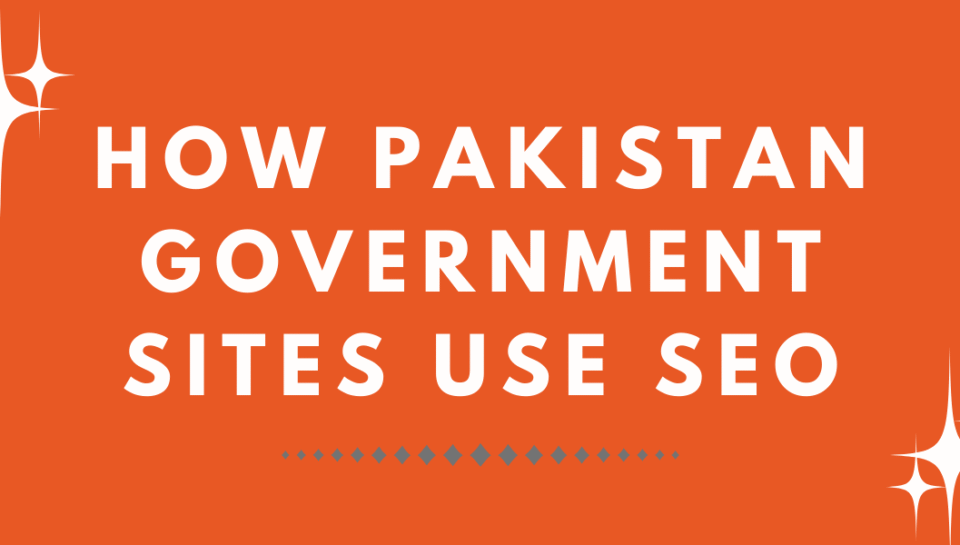
Search engines are the front door to digital government. In Pakistan—where most citizens now access the web via smartphones—effective Search Engine Optimization (SEO) helps people quickly find forms, policies, portals, and critical public-service information. This article explains how Pakistan government websites can and do use SEO to support e-governance, improve service delivery, and strengthen public trust.
Why SEO Matters for Government in Pakistan
Government portals carry high public-interest content—ID registration, tax filing, scholarships, health programs, disaster updates, and regulatory notices. Without strong SEO, citizens may struggle to find official pages, fall prey to misinformation or impostor websites, and spend more time navigating bureaucracy.
Key outcomes of effective public-sector SEO
- Discoverability: Citizens quickly find the right service using queries like “apply domicile certificate Punjab” or “verify CNIC online”.
- Trust and authenticity: Clear branding and structured data help users identify official sources vs. unofficial clones.
- Service completion: Fast, mobile-friendly pages reduce drop-offs in tasks like tax payments or license applications.
- Crisis communication: Search-optimized advisories rank prominently during emergencies (e.g., health alerts, flood relief, subsidies).
- Inclusivity: Urdu and regional-language SEO improves access for non-English-speaking users.
In a market where Google dominates search and mobile usage leads, SEO is an essential layer of public service design.
The SEO Ecosystem for .gov.pk and Provincial Portals
Pakistan’s government digital landscape spans federal, provincial, and departmental sites—e.g., pakistan.gov.pk, NADRA, FBR, provincial portals (Punjab, Sindh, Khyber Pakhtunkhwa, Balochistan), local government boards, and specialized program microsites (e.g., social protection, health insurance, education scholarships).
- Multiple subdomains and legacy systems increase canonicalization challenges.
- Bilingual content (English/Urdu) creates hreflang and duplicate content considerations.
- Public cloud, on-prem, and hybrid hosting configurations affect speed and uptime.
- Content is often policy-heavy; UX and information architecture need deliberate planning to map to search intent.
Technical SEO Foundations Used by Government Sites
Technical SEO ensures that search engines can crawl, index, and understand government content reliably and efficiently.
1) Crawlability and indexation
- Robots.txt: Allow crawling of public pages; disallow admin areas; avoid disallowing essential CSS/JS.
- XML sitemaps: Segment by content type (services, forms, news, departments) and language; submit to Google Search Console.
- Canonical tags: Resolve duplicates across subdomains, HTTP/HTTPS, and versions (English vs. Urdu).
- Noindex rules: Apply to outdated circulars or staging environments to keep search results clean.
2) Performance and Core Web Vitals
- Optimize LCP, CLS, and INP for mobile-first indexing.
- Use caching, compression, modern image formats (WebP/AVIF), and lightweight frameworks to serve low-bandwidth users.
- CDN usage for static assets to improve nationwide delivery and resilience.
3) Security and trust
- Enforce HTTPS across all subdomains; auto-redirect HTTP to HTTPS.
- Strong HSTS and TLS configuration to prevent warnings that harm user trust and SEO.
4) Structured data for rich results
- Organization schema: GovernmentOrganization with officialName, url, contactPoint, logo, and sameAs for verified social channels.
- BreadcrumbList schema to enhance navigational clarity in SERPs.
- FAQPage for procedural guides (“How to apply”, “Required documents”).
- NewsArticle for press releases; Event for public hearings or vaccination drives.
- Speakable (where applicable) to support voice search for essential advisories.
5) Log files and monitoring
- Analyze server logs to catch crawl errors, 404 spikes, and budget waste on parameterized URLs.
- Automate alerts for broken links and uptime issues that impact service accessibility.
On-Page SEO and Content Strategy for Citizen Services
Government content succeeds when it aligns with user intent. Citizens search in task-oriented language: “renew driving license Karachi”, “FBR e-payment”, “CNIC verification online”.
Content patterns that work
- Service pages: Clear, concise “What, Who, Eligibility, Fees, Documents, Steps, Timelines, Contact”.
- Guides and FAQs: Step-by-step instructions, checklists, and examples of valid documents.
- Status and verification pages: SEO-friendly titles/URLs for tracking applications or verifying certificates.
- Policy pages: Executive summaries for citizens, with linked full legal text for researchers.
- Emergency banners: Crawlable, indexable pages for advisories; avoid burying important alerts in images or PDF-only formats.
Metadata that maps to search intent
- Titles: “Apply for [Service] in [Province/City] – Official Government Portal”.
- Meta descriptions: Action-oriented, includes eligibility and primary benefit.
- URL slugs: human-readable, hyphenated, and consistent across English/Urdu versions.
- Headings (H1–H3): Mirror user questions and tasks; avoid jargon.
Media and document SEO
- PDF alternatives: Provide HTML versions of forms and circulars to ensure indexability and mobile readability.
- Alt text: Descriptive alt attributes on seals, emblems, and infographic content.
- Open data: Use machine-readable formats (CSV/JSON) with descriptive filenames and metadata to rank for data queries.
Urdu and Multilingual SEO
Many citizens search in Urdu or mix Urdu/English and Roman Urdu. Effective bilingual SEO respects language, script, and cultural context.
- Hreflang and language attributes: Use hreflang=”ur-PK” for Urdu pages and lang=”ur” in HTML to signal language correctly.
- Right-to-left design: Proper CSS direction for Urdu layouts improves usability and dwell time.
- Keyword research: Include Urdu, Roman Urdu, and English equivalents in planning; map them to dedicated content.
- Consistent translations: Avoid machine-only translations; ensure terms match official usage and citizens’ search phrases.
- Voice search: Optimize headings and FAQs for natural-language queries common in voice assistants.
Local SEO for City and Provincial Services
Services are often jurisdiction-specific. Local SEO helps users find the right office and process for their region.
- Location pages: Dedicated pages for offices in Lahore, Karachi, Peshawar, Quetta, etc., with NAP (Name, Address, Phone) consistency.
- Google Business Profiles (where appropriate): Verified profiles for public-facing service centers, updated hours, and appointment info.
- Regional eligibility: Schema and on-page cues indicating province/city applicability to prevent misdirected traffic.
- Maps and directions: Embedded maps with accessible alt text and labels.
Authority, E‑E‑A‑T, and Trust Signals
Government domains naturally carry authority, but clarity and consistency are still critical to E‑E‑A‑T (Experience, Expertise, Authoritativeness, Trustworthiness).
- Official branding and badge: Clear “Government of Pakistan” markers and updated logos.
- Verified channels: Consistent linking between official social accounts and websites.
- Up-to-date content: Archive outdated advisories; timestamp updates; show responsible department/official.
- Citations: Link to relevant acts, gazettes, and inter-agency references to reinforce authority.
- Contact and grievance redressal: Prominent helplines, feedback forms, and complaint portals.
Accessibility and Inclusive UX
Accessibility is both a public duty and an SEO advantage. Accessible sites earn better engagement and broader reach.
- WCAG-aligned design: Contrast ratios, keyboard navigation, focus states, and ARIA labels.
- Readable typography: Scalable fonts, adequate line spacing, and RTL-aware components for Urdu.
- Plain language: Reduce bureaucratic terms; summarize steps and requirements clearly.
- Mobile-first forms: Minimal fields, validation hints, and offline-friendly instructions.
Analytics, Measurement, and Governance
SEO is sustained by measurement and cross-department coordination.
- Google Search Console: Monitor coverage issues, enhancements, Core Web Vitals, and query patterns.
- Analytics: Track completion of key tasks (appointments booked, applications started/completed).
- Content lifecycle: Review cycles for policy pages, deadlines, and seasonal services (tax season, admissions).
- Editorial governance: Style guides, Urdu/English terminology standards, and metadata templates.
- Change management: Version control for forms; redirects from retired URLs to prevent link rot.
In the context of this evolving landscape, NB Disruptors—an SEO agency based in Pakistan—has observed that the most impactful gains come from unifying technical hygiene with service-focused content and Urdu accessibility.
Common Pitfalls on Government Websites
- PDF-only publishing: Critical instructions locked in non-responsive PDFs reduce rankings and usability.
- Fragmented subdomains: Multiple microsites without canonical strategy create duplicate content and user confusion.
- Slow pages: Heavy scripts and unoptimized images disproportionately hurt citizens on limited bandwidth.
- Unclear ownership: No contact or update logs erode trust and cause outdated information to persist.
- Poor internal linking: Orphaned service pages remain undiscovered by users and crawlers.
Examples and Patterns from Pakistan’s Public Sector
While implementations vary, many agencies are adopting approaches like:
- Centralized portals: pakistan.gov.pk and provincial gateways introduce consistent navigation and service catalogs.
- Task-focused URLs: “/apply-driving-license”, “/verify-certificate”, and “/pay-taxes” patterns that mirror user intent.
- Citizen portal integration: Linking complaint and feedback systems prominently from service pages.
- Schema usage: Breadcrumbs, FAQ, and Organization markup to enhance SERP display and reduce ambiguity.
- Mobile-first design: Streamlined forms and step-by-step guidance that reduce abandonment rates.
Look for these patterns on portals for identity services, taxation, social protection programs, education scholarships, and public health initiatives. When combined with clear metadata and Urdu equivalents, these pages tend to earn strong visibility for transactional queries.
SEO Checklist for Government Web Teams
- Inventory your domains, subdomains, and microsites; consolidate where possible; map redirects.
- Implement robots.txt and XML sitemaps; submit via Search Console; fix coverage errors.
- Adopt consistent URL and metadata patterns for all services; write titles and descriptions for user tasks.
- Add structured data: GovernmentOrganization, BreadcrumbList, FAQPage, and NewsArticle for press releases.
- Build bilingual content with correct hreflang and RTL-friendly design; research Urdu and Roman Urdu queries.
- Improve Core Web Vitals: compress images, defer non-critical JS, and leverage caching/CDNs.
- Replace PDF-only instructions with HTML pages; provide accessible alternatives for downloads.
- Strengthen internal linking from the homepage and service hubs to deep service pages.
- Publish update dates, responsible department, and contact options on each page.
- Measure outcomes: track completion rates for top services; iterate content and UX quarterly.
Keywords and Semantic Topics to Cover on Government Sites
In addition to service-specific nouns and verbs, public portals should naturally include semantic clusters and LSI terms that reflect user language:
- Core terms: government services Pakistan, official portal, online application, verification, renewal, registration.
- Service modifiers: fees, requirements, documents needed, eligibility, processing time, helpline.
- Local context: province, district, tehsil, union council, city names (Lahore, Karachi, Peshawar, Quetta, Multan, Faisalabad).
- Technical SEO: sitemap, robots.txt, canonical, schema.org, Core Web Vitals, mobile-first indexing.
- Trust and access: authenticity, official website, secure, HTTPS, accessibility, Urdu, bilingual.
These terms should be woven into headings, intros, and FAQs—never stuffed—so that pages align with how citizens actually search.
Data Signals That Influence Success
- Query intent: Monitor top queries in Search Console; expand content around “how to” and “requirements” questions.
- Device mix: Most usage is mobile; prioritize mobile CWV, tap targets, and short forms.
- Seasonality: Plan spikes around tax deadlines, admissions, examination results, and budget cycles.
- Engagement: Track scroll depth and form completion; optimize steps with high drop-off.
- Backlink profile: Earn citations from universities, media, and inter-agency portals to reinforce authority.
Future Directions: Beyond Basic SEO
- Search orchestration: Synced site search and on-site “sitelinks search box” markup for faster discovery.
- Knowledge panels: Consistent entity data to help Google build accurate knowledge graphs for ministries and programs.
- Open APIs: Machine-readable endpoints for status checks that third-party apps and assistive technologies can use.
- Proactive answers: Featured snippets from FAQs; concise definition blocks that target zero-click results.
- Resilience: Static fallbacks or lightweight “service status” pages during high-traffic events.
Conclusion
SEO for Pakistan government sites is not about marketing—it is about service delivery, trust, and inclusion. When portals implement solid technical SEO, write task-focused bilingual content, and maintain accessible, secure, and fast user experiences, citizens complete more tasks with less friction. The result is a digital government that feels coherent, credible, and easy to use—exactly what SEO is meant to enable.
Whether you manage a federal portal, a provincial service, or a specialized program site, start with the basics: fix crawlability, adopt structured data, prioritize mobile performance, and craft clear Urdu/English content mapped to citizen intent. Then measure outcomes and iterate. Consistency and governance—not one-off campaigns—are what make public-sector SEO work for Pakistan.




